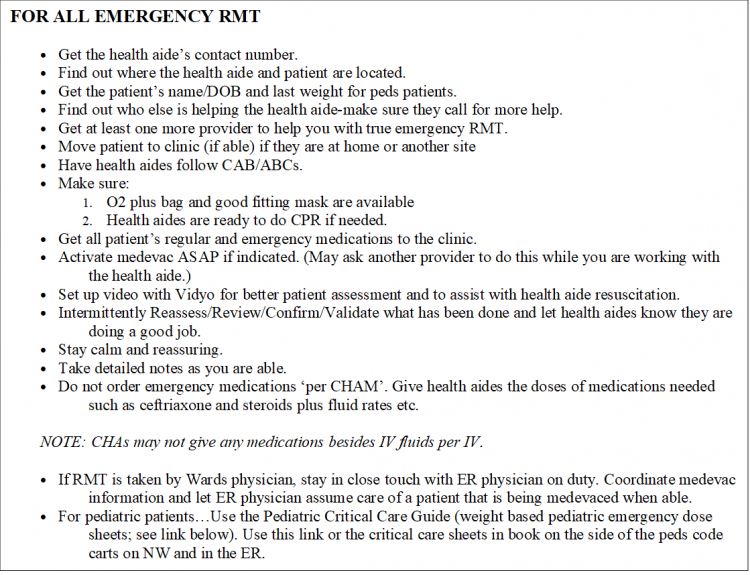CPR in process (Code-Resuscitation)
From Guide to YKHC Medical Practices
There are times when you will get a call from a CHA who is doing CPR on a patient in the home or in the clinic.
- Have the CHA call for more help
- Get as much information as you can about what happened.
- Find out exactly what they are doing and who is there to help them.
- Do not activate a medevac for CPR in progress unless there is a spontaneous return to circulation OR it is a pediatric patient and, in consultation with the pediatrician on call, a decision is made to medevac the patient. CPR in the field without advanced life support is almost never successful. Most CHAs know this. Do the things listed below, keeping in mind that this is generally a futile process, but very necessary for the patient’s family and the CHA.
- Airway open
- Appropriate sized BVM with a good fit and seal
- Patient on O2 with tank O2
- AED placed (even peds)
- Determine if CPR is adequate (fast, effective and can palpate a pulse) and make sure CHA/s are reassessing for this regularly.
- Get glucose and HGB
- Place IV if possible
- Get the patient’s name and DOB, so you can look up the patient’s history.
- VTC Video monitoring if able
- Get the CHA contact number/s in case you get disconnected.
- Stay calm and as reassuring as you can.
- Reassess frequently-Confirm what has been done and let them know they are doing a good job
- Take good notes with times, medications given, interventions done and responses
- Prepare the CHA’s, family and helpers (keep in mind that you are often on speaker phone) for next steps depending on how resuscitation is going.
- If a patient responds to resuscitation , a medevac needs to be activated.
- If the patient is not in the clinic, they should be taken to clinic if safe transportation is possible.
OR
- If resuscitation appears futile (ie effective CPR for > 20 minutes) you will need to go over everything that has been done and make sure there is nothing else that you and the CHAs thinks can be done.
- Prepare the CHAs and family for calling the code.
- It may be necessary to continue CPR longer than you would normally to give the family time to gather and adjust.
- Have the lead CHA step away and talk to you privately for a moment to help them prepare for stopping CPR.
Resuscitation Medications available in the village
- Epinephrine 1:1000 (1 ampule vials).
- Glucagon
- NS Fluid resuscitation
If a code is called you will need to follow the protocol for a Village Death.
- Fax Village death form to Medical Examiner office (if this was an expected death (ie. Palliative care, comfort measures), this form may have already been faxed)
- Call medical examiner’s office
- Notifly Life Alaska (number is on bulletin board on northwing)
- Call state Trooper
- Write free text note documenting events, time of death, etc. And send to Ellen Hodges and Rebecca Tunuchak.
